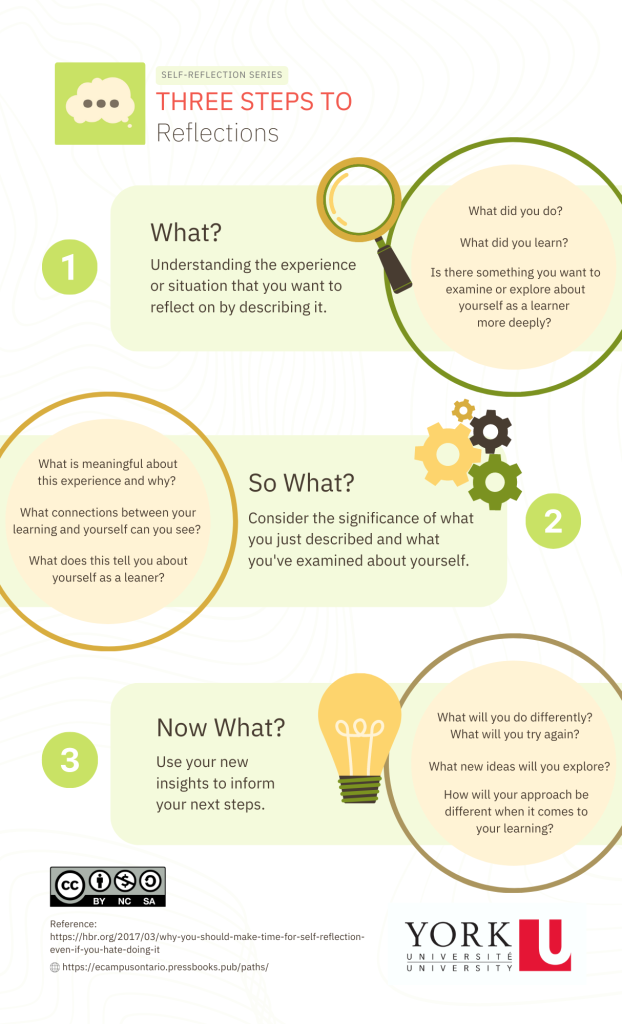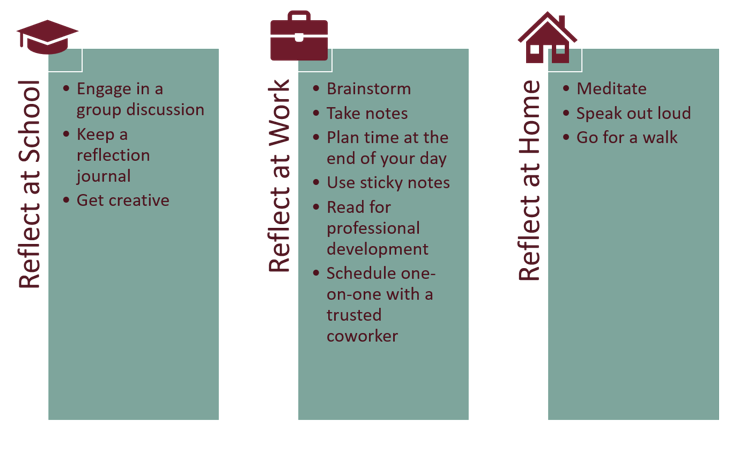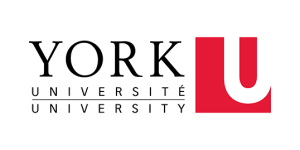3 Reflective Practice
Reflective Practice
Reflective practice is the process of carefully analyzing your experiences to help identify what you have learned and how you might do things differently next time. The goal of reflection within your program is to help you work through your thoughts and feelings about your experience and document your skill development within your Learning Portfolio.
Reflection also helps you to remove yourself from the initial experience so that you can analyze it and see how you might do things differently next time. You can also use reflection to compare, contrast, and bring together experiences from different parts of your life. You will be connecting your work experience with your experience as a Digital Technologies student.
Reflective practice is what ties together your ‘work’ and ‘school’. Reflective practice during WBL encourages you to tie what you are experiencing at work to what you have learned in theory. The goal is to apply theory to practice to see how your experiences support and challenge your school learning. Reflective practice is an important component in WBL because it helps you understand and improve on the job. Reflective practice during the work placement helps you to consider a situation and your actions and determine how well you performed or what you might do differently next time. It is an intentional process to develop a professional and continuous learning practice.
Here are some questions you can ask as you work to build your reflective practice:
- What positive experiences did you have at work today?
- What negative experiences did you have?
- What might you do differently next time?
- What did I witness today that I would like to emulate?
- What would you like to learn more about?
Continuous Reflection for Continuous Learning
Reflective practice has a lot of benefits! Students who participate in reflection have a more in-depth understanding of their learning and can take informed actions. Reflection can help you be a better student and a better worker. However, it is hard work! You need to be willing to explore your thoughts and feelings. Sometimes, reflection can make you feel vulnerable. You may face difficulties with reflection due to fear of judgment, criticism, or feedback. You may also encounter feelings that are hard to resolve or that require you to sit with your own discomfort.
The most important thing you can do when you have trouble with reflection is to keep trying. If you feel challenged, see that as an opportunity for you to grow and develop as a professional. Seeing challenges as threats speaks to a fixed mindset and can encourage us to hold back in our efforts (Dweck, 2016, p. 31). Instead, you want to see yourself as engaged in continually growth and development. Adopting a growth mindset means seeing setbacks and challenges as opportunities to learn (Dweck, 2016, p. 34).
A growth mindset is about establishing that you are capable of doing difficult things. The video below will help add more context to the importance of a growth mindset (6.36 mins).
When you consistently practice reflection, it creates continuous learning and nurtures interest in your work placement journey and how to respond to changes in the workplace. Ongoing reflective practice provides huge benefits for developing and increasing awareness of self and others. It supports the development of creativity and encourages curiosity for deeper insights to inform future actions in work processes.
Driscoll Model of Reflection
As you learn to reflect, it can be helpful to use worksheets or other tools to help you. One of the most important models for reflection was created by John Driscoll in 1994. The Driscoll model incorporates the “what”, “so what”, and “now what” of the experience into your reflection (Driscoll, 1994). This means that you aren’t just describing what happened. You are taking your experience, identifying what was significant about it, and then determining what you should do next. The Driscoll model of reflection is often utilized within clinical settings; however, it can apply to various experiential learning. The model is integrated with Kolb’s learning cycle and includes trigger questions to prompt thinking through reflection. The video (4.48mins.) will illustrate the So What? model.


Driscoll (1994) explains the “WHAT” of the model to recall the experience and what was felt at the time to begin the reflective cycle. “SO WHAT” analyzes the experience, looking at what reactions and feelings the experience created and whether the outcome was successful or disappointing. “NOW WHAT” processes the experience and the lessons to put into context actionable ideas and behaviours to move forward with. Feel free to use the following reflective practice worksheet template as a guide. You may also be asked to use other guided reflection methods in your class.
Ways to Reflect
Reflection can happen at work, at school, and in your personal life. Sometimes, it can be helpful to use different types of reflection to help you get a bit deeper. Here are some common ways you can reflect.

Media Attributions
- “Growth Mindset and Fixed Mindset” by Better Than Yesterday is licensed under the Standard YouTube licence.
- Envision YU – Tools for Student Success Copyright © by Envision YU, York University is licensed under a Creative Commons Attribution-NonCommercial-ShareAlike 4.0 International License, except where otherwise noted.
- Ways to reflect at school, work, and home” by Deb Nielsen, Emily Ballantyne, Fatimah Murad and Melissa Fournier is licensed under a CC BY-NC 4.0 licence.
References
Driscoll, J. (2017). Practising clinical supervision: A reflective approach for healthcare professionals. (2nd ed.). Baillière Tindall Elsevier
Dweck, C. S. (2016). Mindset: The new psychology of success. Random House
Kolb, D. A. (1984). Experiential learning: Experience as the source of learning and development (Vol. 1). Prentice-Hall

